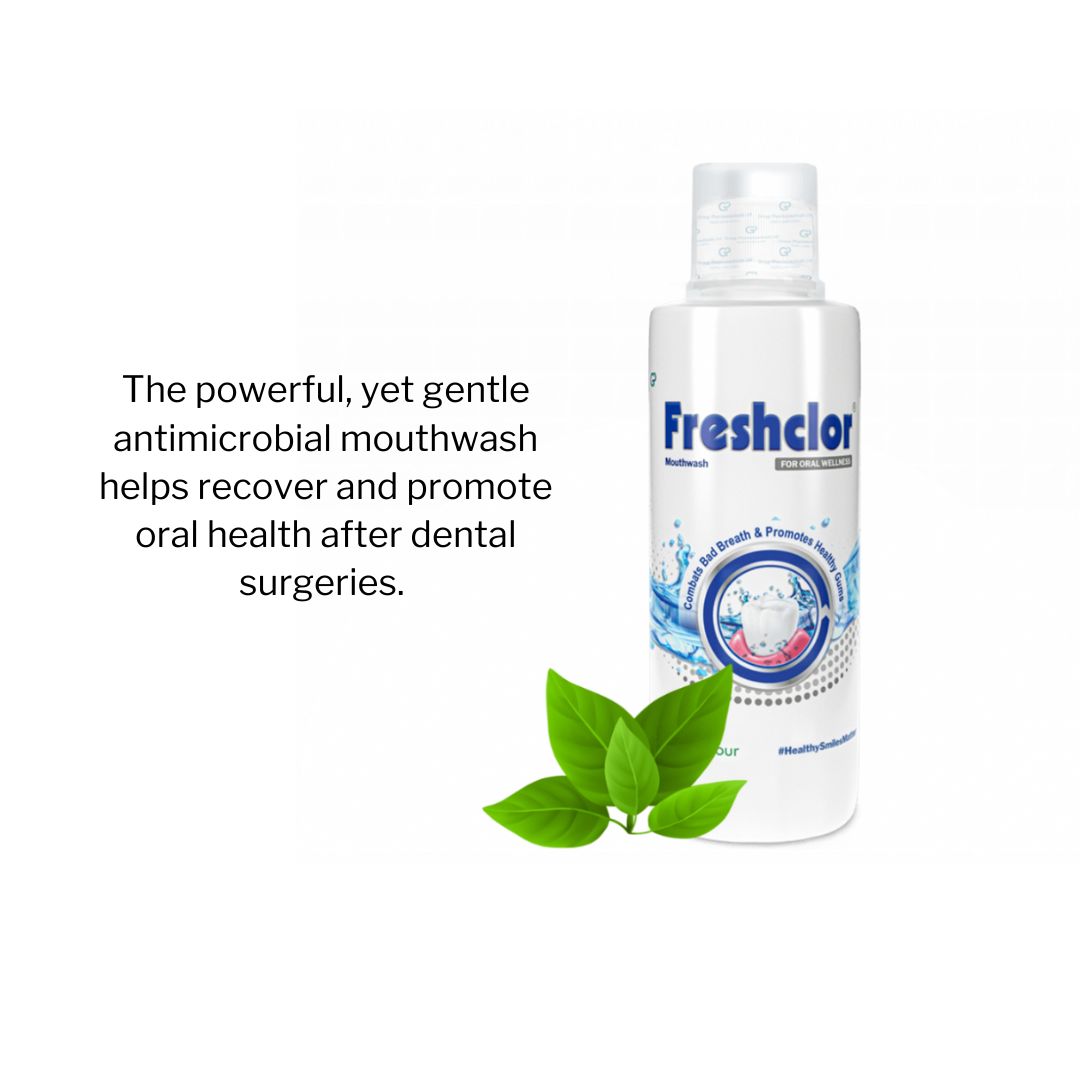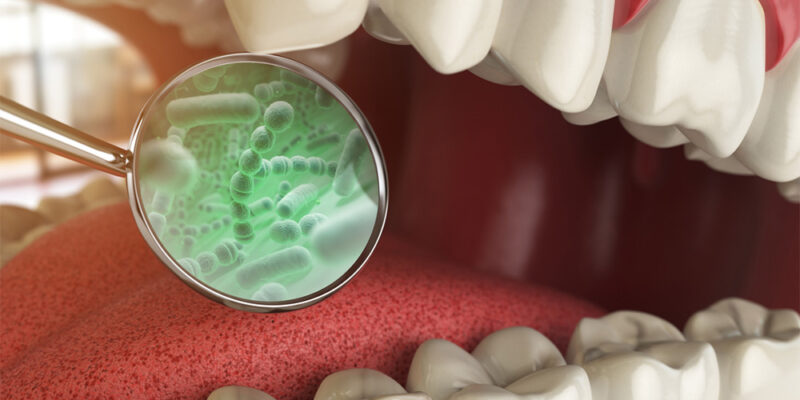Happy Valentine’s Day! Let’s celebrate love and cherish the moments shared with those who make our hearts flutter. And, of course, a friendly reminder that a minty-fresh breath can add an extra touch of sweetness to those special moments.
We get a lot of patients suffering from occasional halitosis, or oral malodor. There can be several reasons for this condition. Understanding the root cause is essential for addressing and preventing the problem. (1,2)
Halitosis is primarily caused by specific bacteria in the mouth, such as streptococci, which are also found in various infections in the body. These cause foul odours in the mouth and may also indicate gum inflammation. Oral bacteria, especially those related to gum disease and periodontitis, can produce volatile sulfur compounds (VSCs). Such compounds are formed when oral bacteria break down food residues, especially proteins and other organic substances. (3)
Certain foods like garlic, onions, and spices can also cause bad breath. However, persistent bad breath may be a sign of underlying health issues. For example, diabetes is known to cause a specific fruity scent in the breath. This may indicate elevated ketone levels, primarily associated with type 1 diabetes. It can also occur in type 2 diabetes with a severe condition known as diabetic ketoacidosis (4)
 Why do we need fresh breath
Why do we need fresh breath
Fresh breath boosts confidence! Halitosis can cause social awkwardness and affect personal relationships because people may hesitate to engage in close conversations.
Several studies (5, 6) indicate that bad breath can be a bigger problem for well-being than is commonly understood. Thus, encouraging patients to improve their oral hygiene and to set up regular dental check-ups can help them manage and alleviate the social impact of bad breath.
Fresh breath is essential in special situations, such as Valentine’s Day, as well as in everyday encounters in all social environments. Good oral hygiene and fresh breath promote the creation of a positive first impression and can also influence professional advancement.
Consider these insights to support your patients in achieving and maintaining fresh breath from dentist Pirta Liljekvist, a Finnish dentist exclusively providing aligner treatments.
Emphasize regular oral care routine
Encourage patients to brush their teeth at least twice daily and floss daily. This simple habit helps remove food particles and plaque from the mouth that can cause bad breath.
– Halitosis can signal to others that personal hygiene may be lacking. A polished appearance won’t save the situation if the breath is stale.
– It can be difficult for the patient to notice himself if the breath smells. The floss test tells mercilessly how others perceive your breath.
Floss test: The patient is asked to floss toward the back of his mouth using an unflavored floss. The patient is then asked to smell the floss.
Stress the importance of hydration
Drinking plenty of water helps to keep the mouth moist and wash away food particles and bacteria. Encourage patients to drink water throughout the day. Dry mouth can lead to bad breath.
in addition to halitosis, caries and periodontitis is more likely in patients with less saliva. If your patient suffers from dry mouth, you should remind them to be especially careful to follow good oral hygiene practices to combat tooth decay and gum disease.
Suggest dietary modifications
Some foods temporarily cause bad breath. For example, otherwise healthy onions and garlic can still linger in your breath the next day. If the patient wants his breath to smell fresh, ask him to avoid them. Fruits and vegetables make good snacks; but one should always take breaks between meals. Frequent snacking is harmful to our teeth. Encourage dental patients to be mindful of their diet choices.
Advocate for sugar-free gum and mints
Chewing gum stimulates saliva production. Suggest sugar-free options to stimulate saliva production and neutralize acids in the mouth.
Encourage tobacco cessation
Inform patients about the detrimental effects of smoking and tobacco use on oral health, including dry mouth and bad breath. Encourage them to quit or seek support to stop smoking. Smoking not only causes bad breath but also increases the risk of gum disease. Quitting smoking can improve their overall health while also enhancing their oral health.
Limit alcohol consumption
Alcohol can lead to dry mouth, which causes bad breath. Remind your patients that alcohol consumption can lead to dry mouth. Limiting alcohol consumption helps maintain saliva production. Also, keep in mind that many mouthwashes contain alcohol. Thus, patients should be reminded to choose an alcohol-free mouthwash if they prefer to use one.
Promote dental check-ups
Remind of the importance of regular dental check-ups to detect potential dental problems early.
Finding the root cause of halitosis starts at the dentist’s office. However, one’s daily activities are crucial. It’s not worth letting bad breath become a social problem because there are ways to address it.
Antibacterial treatment for fresher breath
Lumoral® is an antibacterial and light-activated oral care method developed by Finnish researchers to be used in addition to regular tooth brushing. Its antimicrobial effect targets bacteria on dental surfaces, slows down plaque formation and significantly reduces the burden of harmful bacteria in the mouth. (7)
According to Tommi Pätilä, a cardiac and organ transplant surgeon at the New Children’s Hospital in Helsinki, Finland, Lumoral is a drug-free alternative for treating and preventing severe gum disease. The treatment also helps freshen your breath.
Poor oral health is linked to over 200 chronic diseases. Lumoral® is a product that enhances oral hygiene when used regularly at home. Research suggests that it can also improve the effectiveness of professional dental care. Moreover, it may reduce the need for conventional medications like antibiotics and chlorhexidine to treat gum disease.
The product is suitable for patients of all ages, but it is particularly recommended for those with a history of problems with common oral diseases, tooth decay, and gum disease. (7).
Dentist Pirta Liljekvist reminds that although halitosis can be caused by many factors, improving oral hygiene is an excellent first step. Acquiring a high-quality electric toothbrush is an easy way to improve oral health. Adding antibacterial light-activated treatment to a daily oral hygiene routine enhances the effectiveness of oral cleaning and helps when traditional oral hygiene methods are insufficient. (7)
Using mouthwashes is a common way to try to control bad breath, but the problem with antibacterial mouthwashes is that they destroy not only harmful bacteria but also the beneficial microbiota in the mouth. Many mouthwashes also contain alcohol, which has been linked to the development of oral cancer in scientific studies (8). It is also important to note that long-term use of antibacterial mouthwashes, such as chlorhexidine, can adversely affect the taste and cause tooth discolouration.
This novel antibacterial method for oral health differs from mouthwashes because it does not contain alcohol and targets plaque. Its antibacterial effect has been shown to be stronger than mouthwashes, but because it is targeted, it does not disturb the diversity of the oral microbiome. Since bacteria cannot develop resistance to the treatment, it is suitable for regular use.
– Using Lumoral helps keep harmful mouth bacteria in check. As a dentist, I have noticed with pleasure at my practice that those who use the device regularly have less gum inflammation than those who do not, emphasizes Pirta Liljeqvist.
Disclaimer: The views and opinions expressed in this article are that of the author alone and does not necessarily reflect the official policy of DentalReach. DentalReach does not endorse, promote or associate with this product and this article is meant for informative purposes only.
References
- Krespi YP, Shrime MG, Kacker A. The relationship between oral malodor and volatile sulfur compound-producing bacteria. Otolaryngol Head Neck Surg. 2006 Nov;135(5):671-6. doi: 10.1016/j.otohns.2005.09.036. PMID: 17071291.
- Newman T. Everything you need to know about bad breath. https://www.medicalnewstoday.com/articles/166636
- Medical Journal Duodecim, 26.1.2022, Osmo Saarelma, Specialist in General Medicine, Bad breath (halitosis)
- González-Moles MÁ, Ramos-García P. State of Evidence on Oral Health Problems in Diabetic Patients: A Critical Review of the Literature. J Clin Med. 2021 Nov 18;10(22):5383. doi: 10.3390/jcm10225383. PMID: 34830663; PMCID: PMC8618619.
- Veeresha KL, Bansal M, Bansal V. Halitosis: A frequently ignored social condition. J Int Soc Prev Community Dent. 2011 Jan;1(1):9-13. doi: 10.4103/2231-0762.86374. PMID: 24478947; PMCID: PMC3894075.
- Wu, J., Cannon, R.D., Ji, P., Farella, M., Mei, L. (2020) Halitosis: prevalence, risk factors, sources, measurement and treatment – a literature review. Australian Dental Journal https://doi.org/10.1111/adj.12725
- Pakarinen, S.; Saarela, R.K.T.; Välimaa, H.; Heikkinen, A.M.; Kankuri, E.; Noponen, M.; Alapulli, H.; Tervahartiala, T.; Räisänen, I.T.; Sorsa, T.; Pätilä, T. Home-Applied Dual-Light Photodynamic Therapy in the Treatment of Stable Chronic Periodontitis (HOPE-CP)-Three-Month Interim Results. Dent. J. 2022, 10, 206. https://doi.org/10.3390/dj10110206
- Boffetta P, Hayes RB, Sartori S, et al. Mouthwash use and cancer of the head and neck: a pooled analysis from the International Head and Neck Cancer Epidemiology Consortium. Eur J Cancer Prev 2015; [Epub ahead of print] PubMed PMID: 26275006; PubMed Central PMCID: PMC4752930.





















Comments